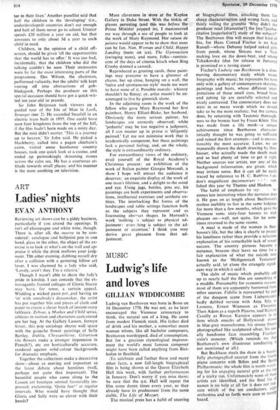ART
Ladies' nights
EVAN ANTHONY
Reviewing art shows can be a giddy business, particularly if you attend the openings. It isn't all champagne and white wine, though. There is, after all, the oeuvre to be con- sidered : catalogue and ballpoint pen in one hand, glass in the other, the object of the ex- ercise is to look at what's on the wall and ap- praise it while the drink mellows your judg- ment. The other evening, dabbing myself dry after a collision with a gesturing fellow art lover. I was charmed by a lady who said, 'Lovely, aren't they. I'm a relative.'
Though I wasn't able to share the lady's pride in kinship, I can concede that the ex- travagantly framed collages of Gloria Stacey may have, for some, a certain appeal. Wielding a wicked paste-pot, and having an 'in' with somebody's dressmaker, the artist has put together bits and pieces of cloth and paper to create a clever batch of instant-story tableaux. Zebras, a Mother and Child series, athletes in motion and characters caricatured are her bag. At the Gallery Lasson, Jermyn Street, this pop sociology shares wall space with the gouache flower paintings of Sally Bartley. Dahlia, Chrysantheme, Geranium (do flowers make a stronger impression in French?), etc are horticulturally accurate, rendered against solid-colour backgrounds for dramatic emphasis.
Together the collections make a decorative show—about as moving and important as the latest debate about hemlines (well, perhaps not quite that important). The beautiful people who came along to the Lasson art boutique seemed favourably im- pressed, exclaiming, 'Quite fun!' at regular intervals. Who would have thought that Gloria and Sally were so clever with their hands? More cleverness in store at the Kaplan Gallery in Duke Street. With the tinkle of glasses persisting (and this was before the Prime Minister popped in), I manoeuvred my way through a sea of people to look at the work of Mary Raymond. Her raison de peintre would appear to be to show that nuns can be fun. Nun, Woman and Child, Happy Landing (nuns on ice), The Gymnasium (swinging nuns), and more, folks—reminis- cent of the days of cinema kitsch when Bing Crosby donned a cassock.
Reproduced as greeting cards, these paint- ings may presume to have a glimmer of charm, but up close, hanging on a wall, the 'naive and spontaneous style' made me want to have none of it. Possible morals: whimsy shouldn't be flimsy; or, artist mustn't be en- couraged to live by gimmick alone.
In the adjoining room is the work of the fellow who gave Mary Raymond her first paintbox, Henry Elliott-Blake, her husband. Obviously the more serious painter, his landscapes are earnestly observed; while 'pedantic' may be too negative a judgment, all I can muster up in praise is 'diligently painted.' Let me not minimise work that is academically competent, but these paintings lack a personal feeling, and, on the whole, the style is extraordinarily ordinary.
For extraordinary views of the ordinary, avail yourself of the Royal Academy's Christmas present: an exhibition of the work of Italian painter Giorgio Morandi, a show I hope will attract the audience it deserves: an exquisite display of the work of one man's lifetime, and a delight to the mind and eye. Using jugs, bottles, pots etc, his paintings are both experiments and observa- tions, intellectual exercises and aesthetic en- tities. The interlocking flat forms of the landscapes and table settings function both as the subjects they represent and as fascinating abstract shapes. In Morandi's work 'nothing is subject to physical ad- justment: every,hing is subject to the ad- justment of attention.' I think you may derive great pleasure from that ad- justthent.






































 Previous page
Previous page